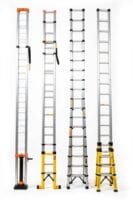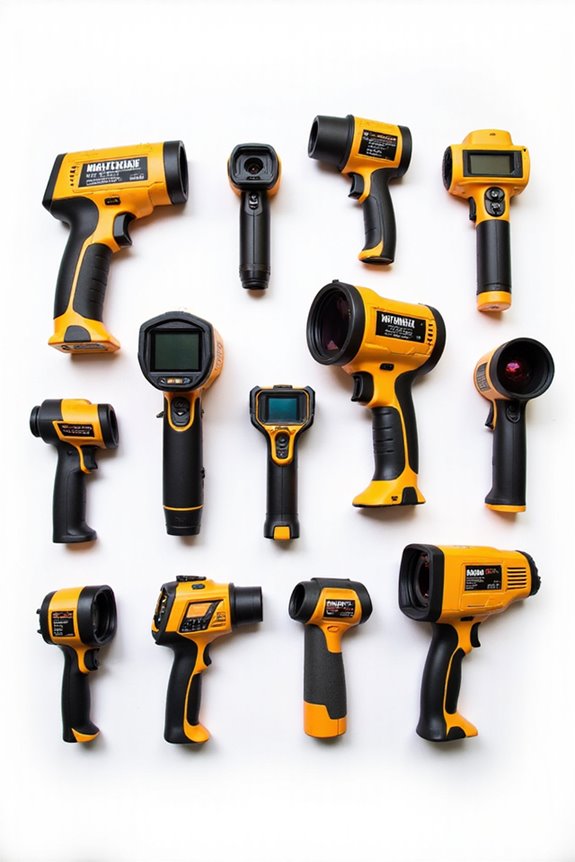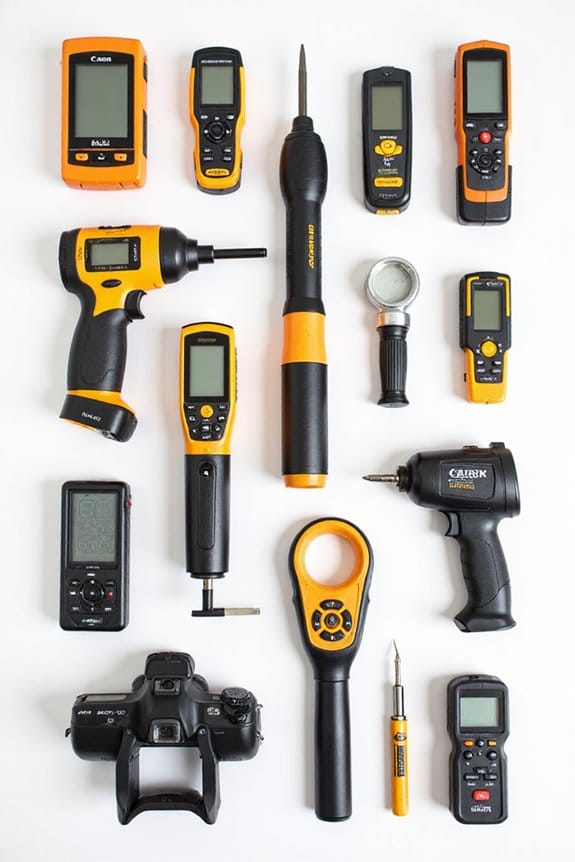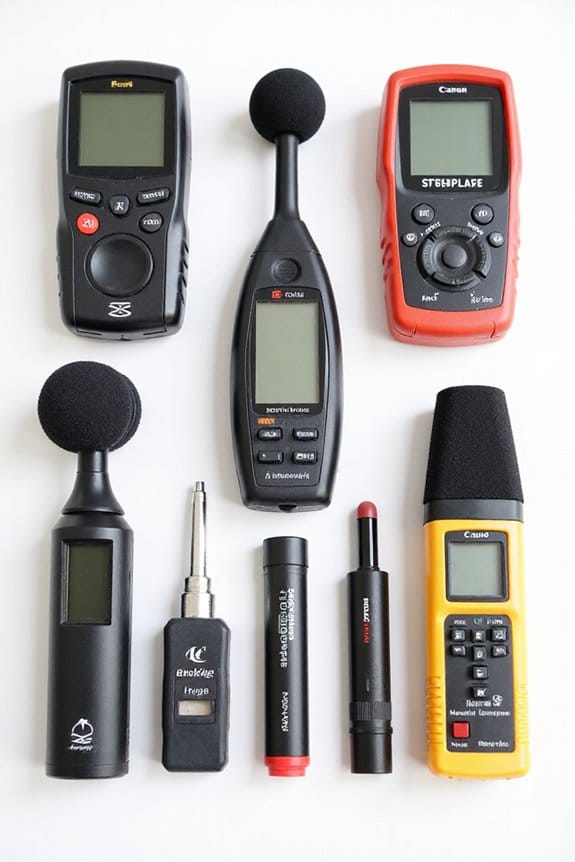As an Amazon Associate, we earn from qualifying purchases. Some links may be affiliate links at no extra cost to you. Although our opinions are based on curated research, we haven't used these products. Articles generated with AI.
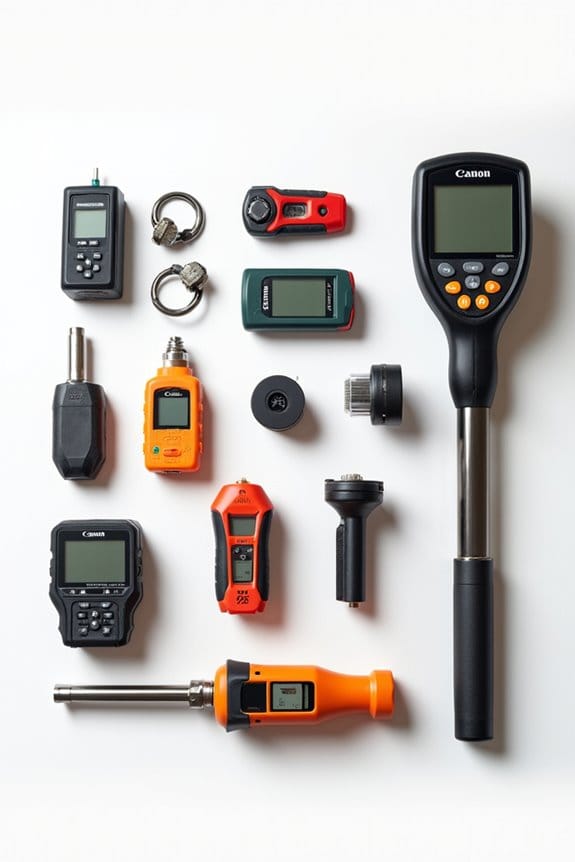
The 5 Best Gas Sensors of 2025: Safeguard Your Home With These Top Picks
Looking to keep your home safe from gas leaks? Check out these top five gas sensors for 2025: 1) WGRLIT D730 – fast detection, vibrant alarms; 2) Natural Gas Leak Detector for Home and RV – multi-gas capabilities, simple installation; 3) 9pcs Sensor Module Kit – perfect for DIY projects; 4) TopTes PT177 – ultra-responsive; and 5) convenient plug-in options. Each has its strengths, so find the right fit that suits your needs—stick around to learn more about what to take into account!
Key Takeaways
- Choose the WGRLIT D730 for fast detection and a loud alarm, perfect for quick response to gas leaks.
- Opt for the multi-gas detector for home and RV use, ensuring detection of various gases with easy installation.
- The TopTes PT177 provides versatile detection with a quick response, ideal for portable safety monitoring.
- Consider power source reliability; battery-operated models offer flexibility while plug-in models ensure consistent operation.
- Verify compliance with safety standards like UL1484 and EN50194 to ensure reliable and effective gas detection systems.
Explosion-Proof Natural Gas Detector Alarm
Explosion-Proof Natural Gas Detector Alarm - Ultra-Sensitive CH4/Propane Gas Leak Alert with 85dB...
- 【10-Second Military-Grade Detection】MEMS sensor array detects CH4/propane leaks at 8% LEL (±3% accuracy) within 10 seconds. Smart Auto-Calibration with environmental...
- 【3D alarm Matrix with 85dB Pulsed Siren】360° warning system: 85dB aviation-grade alarm (30m range) + 4-LED strobe array (120° coverage). Four-color smart indicator:...
- 【10-Year Aerospace-Grade Durability】Explosion-proof ABS+PC composite passes 2000hr aging tests.Self-diagnosis chip monitors component health, with yellow LED warning...
If you’re looking for a reliable gas detector for your home, RV, or camper, the WGRLIT D730 Natural Gas/Propane Detector might just be your best choice. Here’s why:
- Fast Detection: It uses a military-grade MEMS sensor array, detecting leaks within 10 seconds. That’s faster than you can say “fire hazard!”
- Loud Alarm: The 85dB alarm and strobe lights guarantee you’ll hear it from 30 meters away. Just don’t ignore it.
- Portable Design: Battery-operated and compact, it’s easy to fit anywhere. Plus, the self-diagnosis chip keeps everything running smoothly.
Best For: Those looking for a reliable and portable gas detection solution for homes, RVs, or camper vans.
Pros:
- Battery-operated design allows for flexible placement without needing an outlet.
- Compact and visually appealing, easy to install in various locations.
- High sensitivity, detecting gas leaks at 8% LEL with quick 10-second response time.
Cons:
- No plug-in option, relying solely on battery power, which may lead to concerns about battery life.
- Some users have reported alarm failures during testing with gas sources.
- Lack of visible certification seals raises questions about independent testing reliability.
Natural Gas Leak Detector for Home and RV
Sale
HSTMYFS Natural Gas Leak Detector, Plug-in Propane Natural Gas Detector for Home Kitchen RV,...
- Versatile Gas Detection: This gas detector is designed for home use and can detect multiple combustible&explosive gases, including LPG (methane), CNG, LPG, Propane and...
- Photoelectric Warning System: When the concentration of combustible gas reaches a preset level, the alarm emits an 85 dB audible and visual signal, alerting you to check...
- Proven Safety: Our gas detector undergoes rigorous quality management, with over a decade of successful sales to verify its stability and reliability.
For homeowners and RV enthusiasts seeking peace of mind regarding gas safety, the Natural Gas Leak Detector offers an unmatched blend of simplicity and reliability. Here’s why you’ll want one:
- Multi-Gas Detection: It detects LPG, CNG, Propane, and Natural Gas—your safety net against various hazards.
- Easy Installation: Plug it in, wait just 2-3 minutes, and you’re set. Testing is a breeze, too!
- Loud and Clear Alerts: With an 85 dB alarm, you’ll hear it even if you’re in the garage.
While some users report false alarms, it’s still a small price for peace of mind. Don’t skimp on safety!
Best For: Homeowners and RV enthusiasts seeking reliable protection against gas leaks in their living spaces.
Pros:
- Multi-Gas Detection: Effectively identifies various gases including LPG, CNG, Propane, and Natural Gas.
- User-Friendly Installation: Plug-and-play setup with a simple 2-3 minute warm-up period.
- Reliable Alerts: Provides loud 85 dB alerts to ensure you’re warned of any potential gas leaks.
Cons:
- Accuracy Issues: Some users report false alarms, raising concerns about reliability.
- Sensitivity to Cooking Fumes: May trigger alerts due to common cooking smells.
- Power Dependency: Operates on AC power, meaning it won’t work during power outages.
9pcs Gas Detection Sensor Module Starter Kit for Arduino Raspberry Pi
ACEIRMC 9pcs/Lot Gas Detection Sensor Module MQ-2 MQ-3 MQ-4 MQ-5 MQ-6 MQ-7 MQ-8 MQ-9 MQ-135 Sensor...
- MQ-2 gas sensor sensitive material used in the clean air low conductivity tin oxide (SnO2). When there is the environment in which the combustible gas sensor,...
- Quick response and recovery characteristics
- The dual signal output (analog output and TTL output)
Looking to plunge into the world of gas detection without breaking the bank? The 9pcs Gas Detection Sensor Module Starter Kit for Arduino and Raspberry Pi is your ticket. Here’s why this kit’s a great option:
- Diverse Sensors: It includes MQ-2, MQ-3, and others, giving you a range of gas detection capabilities.
- Dual Outputs: Enjoy both analog and TTL outputs for versatile projects.
- User-Friendly: Most users find the integration into their setups smooth and satisfying.
Just be cautious about sensor quality—some poor solder joints have been reported. But overall, it’s a solid choice for budding tech enthusiasts!
Best For: Hobbyists and beginners looking to explore gas detection with affordable and versatile sensor options.
Pros:
- Diverse Sensors: Includes a variety of gas detection capabilities (MQ-2, MQ-3, etc.).
- Dual Outputs: Offers both analog and TTL outputs for flexible project integration.
- User-Friendly: Smooth integration reported by most users, enhancing the project experience.
Cons:
- Quality Concerns: Some sensors exhibit poor solder joints and corrosion issues.
- Identification Confusion: Only three sensors labeled correctly, leading to potential identification errors.
- Documentation Issues: Unclear information regarding sensor types, such as carbon monoxide vs. carbon dioxide.
TopTes PT177 Natural Gas Detector
Natural Gas Detector, TopTes PT177 Gas Leak Detector with Audible & Visual Alarm, Portable Gas...
- Combustible Gas Leak Detector: PT177 is a useful little tool that helps every household with gas appliances to quickly and easily pinpoint the leakage of combustible gas...
- Visual and Audible Alarms: PT177 gas detector requires a 30-second auto-calibration after powering on and can detect gas and trigger an alarm within 0.5 to 3 seconds....
- Pocket sized with a pocket clip that allows you to carry it in your shirt pocket. The included storage bag makes the natural gas detector easy to store. It is a...
The TopTes PT177 Natural Gas Detector is your trusty companion for home safety, especially designed for homeowners and DIY enthusiasts keen on preventing gas leaks. Here’s what makes it a must-have:
- Versatile Detection: It picks up LPG, methane, and even propane—safe for various appliances.
- Quick Alerts: With a response time of just 0.5 to 3 seconds, you’ll know immediately if there’s trouble.
- Compact Design: Weighing only 0.12 kg, it’s easy to carry around with a handy clip.
- User-Friendly Features: The auto shut-off and battery indicator make it hassle-free.
Stay safe and avoid old-school leak detection methods—grab your TopTes today!
Best For: Homeowners and DIY enthusiasts who want a reliable and portable solution for detecting gas leaks.
Pros:
- Compact and lightweight design makes it easy to carry and store.
- Quick response time of 0.5 to 3 seconds for immediate detection of gas leaks.
- User-friendly features such as auto shut-off and low battery indicator enhance convenience.
Cons:
- Battery-powered design may require frequent battery replacements.
- Some users may find the sensitivity to be overly responsive in certain conditions.
- Limited to combustible gases, so not suitable for other types of gas detection.
Natural Gas Leak Detector for Home and RV
Natural Gas Leak Detector for Home, Plug-in Propane Gas Detector for LPG, Methane, Propane, Butane,...
- Keep Safety - When combustible gases leaking (kitchen methane / natural gas ) detected, the natural gas detector will emit 85dB slow, accelerating, rushing, continuous...
- Functions - This gas detector precisely measures and easy to use. Gas which can be detected includes natural gas (Main Components: Methane), liquefied gas (Main...
- Durable & Energy saving - Plug-In propane detector design, for home use, A/C-powered, makes it super easy and convenient to install. This Flame-retardant ABS plastic,...
A natural gas leak detector designed for home and RV use is essential for anyone who values safety and peace of mind. Here’s why you should consider getting one:
- Multiple Gas Detection: It detects LPG, methane, propane, butane, and city natural gas. Safety in diverse settings is key, right?
- Loud Alarm: An 85dB alarm sounds when combustible gas leaks are detected. It’s hard to ignore, even if you’ve got your favorite TV show cranked up!
- Easy Installation: Just plug it in! There’s no hassle, and it’s energy-efficient at just 2 watts.
Stay safe, avoid those sneaky gas leaks, and enjoy your home or RV worry-free!
Best For: Individuals and families looking for peace of mind and safety in their homes or RVs against natural gas leaks.
Pros:
- Multiple Gas Detection: Effectively identifies various combustible gases, ensuring safety in diverse environments.
- Loud Alarm: The 85dB alarm provides a strong alert, making it difficult to miss in emergency situations.
- Easy Installation: The plug-in design offers hassle-free setup and energy efficiency.
Cons:
- Design Flaw: The detector can block adjacent outlets, causing inconvenience for users.
- False Alarms: Reports of false alarms after prolonged use can lead to frustration and concerns about reliability.
- Quality of Materials: Some users have noted disappointment with the durability and construction quality compared to previous models.
Factors to Consider When Choosing a Gas Sensor
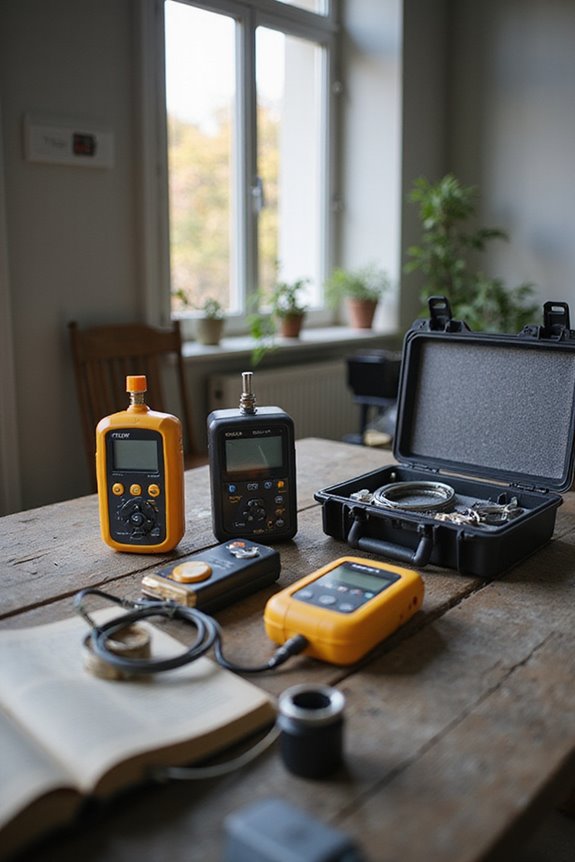
When you’re selecting a gas sensor, consider a few key factors to guarantee you make the right choice. You’ll want to think about detection sensitivity levels, power source options, and how easy it is to install. And hey, don’t forget the alarm sound output and design—nobody wants a sensor that looks like it’s from the ’80s!
Detection Sensitivity Levels
Choosing the right gas sensor doesn’t just depend on the brand; detection sensitivity levels play a key role in guaranteeing safety. Here are some factors to keep in mind:
- Lower Explosive Limit (LEL): Most sensors activate alarms at 8% LEL for gases like methane and propane. This guarantees you’re alerted quickly.
- Technology Matters: High sensitivity sensors, like MEMS arrays or gas-sensitive semiconductors, can spot combustible gases within seconds.
- Dual Outputs: Some detectors offer both analog and TTL signals, enhancing their sensitivity and effectiveness.
- Sensor Design: Tin oxide-based sensors are known to be highly sensitive to harmful gases.
- Environment Counts: Humidity and temperature can impact sensitivity. Choose wisely based on your home’s conditions!
Power Source Options
Selecting the right power source for your gas sensor is essential to guarantee its reliability and effectiveness. Here are a couple of options to evaluate:
- Battery-operated sensors: These are flexible and can be placed almost anywhere, using AA batteries. They offer portability but may leave you in a pinch during power outages. Plus, don’t forget to stock up on batteries!
- Plug-in models: These sensors need an AC power source, providing a consistent supply. They’re perfect for long-term use but watch out for electrical failures—unless they have a backup battery.
Installation and Setup
Installing a gas sensor can feel a bit like putting together a puzzle; you want all the pieces to fit just right to confirm it functions effectively. Here are some key factors to take into account:
- Power Source: Check if it’s battery-operated or needs AC power. This impacts where you can place it.
- Installation Hardware: Look for products that come with all the necessary hardware and easy-to-follow manuals.
- Size and Design: Compact designs make it easier to fit your specific space, whether that’s in your home or RV.
- Warm-Up Period: Some sensors need a few minutes to get going.
- Testing Features: Verify it includes maintenance options like self-diagnosis for peace of mind. Happy installing!
Alarm Sound Output
When it comes to making your space safe from gas leaks, the alarm sound output of a gas sensor is an essential factor you’d want to contemplate. Here are a few points to keep in mind:
- Decibel Levels: Look for values between 75 dB and 85 dB—loud enough to be heard in most home environments.
- Alarm Type: Continuous tones or beeping patterns can change how you respond. Choose what feels most urgent to you!
- Visual Indicators: Some models come with strobe lights, enhancing visibility for those with hearing difficulties.
- Response Time: A top alarm system activates within seconds, aiding timely evacuation.
- Regulatory Compliance: Verify your gas detector meets safety standards for peace of mind.
Your safety is important, so don’t overlook these details!
Design and Portability
Choosing the right gas sensor isn’t just about functionality; design and portability are just as important. Here are some key factors to evaluate:
- Size and Weight: Opt for compact sensors. They’re easier to carry whether you’re at home, in your RV, or camping.
- Installation Method: Look for plug-in options or those with simple wall-mounted hardware. Quick installation is a win!
- Material Durability: Pick models made from flame-retardant ABS plastic. They’ll last longer and withstand various environments.
- Power Source Flexibility: Battery-operated sensors offer portability, while plug-in types provide continuous power. Reflect on what suits your needs best.
- Design Features: User-friendly designs with indicators for battery life or alarm status make everything smoother. Choose wisely!
Compliance and Certifications
Understanding compliance and certifications is essential for ensuring you pick a reliable gas sensor that meets safety and performance standards. Here are key factors to evaluate:
- Safety Standards: Make sure your sensor complies with UL1484 and EN50194 for residential or mobile use. It’s like having a safety net!
- Independent Lab Certifications: Look for seals that validate claims. If it sounds too good to be true, it might just be.
- FCC Markings: These indicate compliance with electromagnetic radiation specifications. Your sensor shouldn’t be vying for radio airtime!
- Industry Certifications: Different gases may need specific certifications, so check carefully.
- Warranty and Support: A solid warranty can provide peace of mind. After all, who doesn’t love a backup plan?
Maintenance and Lifespan
While you might think that once you install a gas sensor, it’s good to go indefinitely, that’s far from the truth. Here are a few key factors to keep in mind about maintenance and lifespan:
- Lifespan: Most gas sensors last about 5 to 10 years. Plan for replacements!
- Regular Checks: Perform self-diagnosis checks every few months to keep things running smoothly.
- Warning Systems: Watch for alerts like a yellow LED, which signals it’s time to replace your unit—often 90 days in advance.
- Environmental Impact: Be mindful of humidity and temperature; they can affect performance.
- Testing: Follow the manufacturer’s guidelines to regularly test your sensor. Better safe than sorry! Keep your home safe and your sensors in check!
Frequently Asked Questions
How Do Gas Sensors Detect Different Types of Gases?
So, you think gas sensors just sit there and smell? Not quite! Here’s how they detect different gases:
- Chemical Sensors: They rely on reactions with specific gases, causing measurable changes.
- Infrared Sensors: They use light absorption principles; each gas absorbs unique wavelengths.
- Ultrasonic Sensors: These detect sound wave changes, helpful for checking gas leaks.
Are Gas Sensors Safe for Indoor Use?
Yes, gas sensors are generally safe for indoor use. Here’s why:
- Continuous Monitoring: They constantly check the air, alerting you to potential hazards.
- Low Emissions: Most sensors use minimal power, producing little noise and no harmful emissions.
- User-Friendly: They’re easy to install and maintain, making your life simpler.
Just remember, it’s crucial to place them in proper locations—like near gas appliances. Your safety’s worth it!
How Often Should I Replace My Gas Sensor?
You should replace your gas sensor every 2 to 5 years, depending on the manufacturer’s recommendation. Here’s a quick guide:
- Check the manual – It’ll usually list recommended replacement intervals.
- Listen to alerts – If your sensor starts beeping, it might be time for a new one.
- Stay proactive – Regular checks can save you from gas-related surprises.
Can Gas Sensors Work in Extreme Temperatures?
Absolutely, gas sensors can work in extreme temperatures, but not all of them perform well in severe conditions. Here’s what you need to know:
- Temperature Range: Check the manufacturer’s specs for the ideal operating range.
- Calibration: Sensors might need recalibration after temperature extremes.
- Placement: Make sure to install them in a sheltered spot.
What Maintenance Do Gas Sensors Require?
Gas sensors need regular maintenance to keep working effectively. Here’s what you should do:
- Monthly Check: Test your sensor to verify it’s functioning. A simple push of the test button helps.
- Clean Sensors: Dust can interfere with readings. Wipe down the exterior occasionally.
- Replace Batteries: If your sensor uses batteries, swap them out yearly.
Stay proactive—these steps can help you avoid surprises! Trust me, your nose will thank you later!



